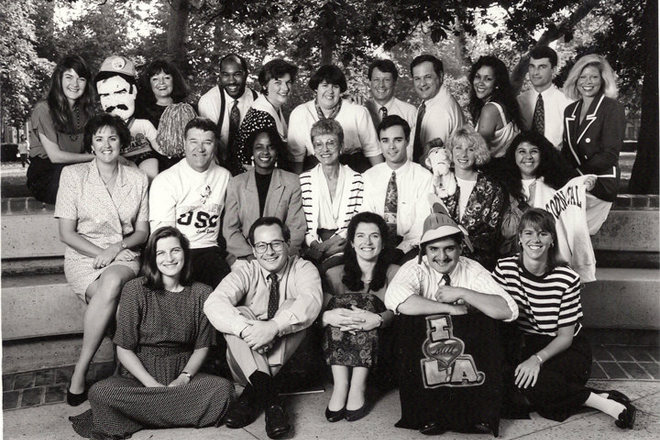Like many people who started their careers in admissions work in the 1980s, I fell into it backwards. Universities at the time were embracing the concept of strategic enrollment management and targeted admission outreach work, instead of waiting for students to come to them. To accomplish this, many hired large recruiter staffs to cover hundreds if not thousands of high school visits.
I was in my early 20s when I got my first admissions job, working for my alma mater, the University of Southern California. I had just finished my master’s degree at USC, in French of all useful subjects, and it was beginning to dawn on me that the next step — moving into a Ph.D. program and the subsequent life of a higher ed professor of Romance languages — was probably not the direction in which I wished to head.
I was searching. A friend of mine from my undergraduate days who had gone to work in the university’s admissions office thought I’d do well in the field and encouraged me to apply for an opening. Having absolutely no idea what an admissions officer was or did, I applied. Probably because I was a fairly recent graduate with a solid GPA, a knack for school and an outgoing personality, I got the job.
On my first day, I learned I was to be what they called a “roadrunner.” Admission roadrunners in universities in the 1980s and 90s managed territories of schools and did hundreds of high school visits and college fairs. In my first fall, I did four high school visits a day for 10 weeks plus local and regional college fairs at night and on weekends. As the newest person on staff, I was given outlier territories, and I had to make my recruiting numbers every single week, which were measured by the number of inquiry cards I got from students at each of these events.
Roadrunner staff typically turned over in less than two years, but there was something about it that I loved. It was fascinating trying to predict what type of outreach might yield the best potential outcome for the kind of students we most wanted, who could both transform our institution and be transformed by it.
I was loaded with hundreds of branded pens and a heavy Kodachrome carousel style slide deck that showcased the campus. I knew the “5 Main Messages” speech backwards and forwards, for any size audience. In the days before cell phones or GPS, I navigated my way based on AAA Auto Club maps, which I dutifully highlighted the night before, and I quickly learned to look for the flagpole on a campus because it was usually closest to a main office.
The roadrunners’ job was to make it as enticing as possible to apply for admission while maintaining ethical standards. Roadrunner staff typically turned over in less than two years, but there was something about it that I loved. It was fascinating trying to predict what type of outreach might yield the best potential outcome for the kind of students we most wanted, who could both transform our institution and be transformed by it. That got me hooked forever.
In those early days of enrollment management, our roles were more like cruise directors who enticed students to apply and helped them navigate the process. This was a phase beyond the earliest days of admission work, when a headmaster, headmistress or an academic dean determined who merited entry into an academic institution, usually by way of letters of reference. We played the roles of both gatekeeper and concierge at the same time, holding the responsibility of access without wielding any significant power beyond said gate.
Much would change in the decades to come. I have been fortunate to be part of the adjunct faculty of the University of Southern California’s Rossier School CERPP certificate program (Center for Enrollment Research, Policy and Practice), which offers a distinctive certificate in leadership in enrollment management. One of our lecturers in the program is Don Hossler, a nationally-recognized leader of university strategic enrollment management, who has written several books on the topic. He explains that the field shifted due to a confluence of demographic, societal and institutional change that drove expansion for colleges and universities from the 1950s through the 1970s. As more families understood the value of a college education, demand grew and these decades saw the rise of community colleges, regional and state colleges, and increased selectivity for private colleges and universities.
During the 1970s, growth slowed and the need to market one’s institution grew. In 1976, Boston University’s Jack Maguire coined the term “enrollment management” to describe his increasingly data-informed process that used predictive analytics to better understand how to attract and retain students. Maguire’s new term resonated not just because of demographic trends, public policy shifts, and marketing and retention strategies, but also due to the organizational integration of academic advising, admissions, financial aid and marketing functions. Working together, these departments began to drive stronger collaborative and data-informed enrollment strategies.
Universities came to understand that the better their student recruitment and selection was, the better their retention and the higher selectivity. This continuous circle fed itself, as more and more higher education institutions adopted a strategic enrollment management system seeking the best “mission-fit” students through their integrated approaches.
I learned the tools of predictive analytics while rising through the ranks of undergraduate admission at the University of Southern California. During those years, as the admission office team worked to increase the profile of the university, the need for strategic enrollment strategy and the importance of collaboration across departments became clear.
While independent schools have been slower to adopt the strategic enrollment management framework, the same issues that converged for colleges have now become the norm for many independent schools. Market realities have inspired more independent schools to pay attention to such issues as changes in the stock market, demographic trends, and of late, the bifurcation of wealth and poverty in the United States.
I carried those skills and perspectives with me when I began to serve as Viewpoint School’s director of admission in 2003. While independent schools have been slower to adopt the strategic enrollment management framework, the same issues that converged for colleges have now become the norm for many independent schools. Market realities have inspired more independent schools to pay attention to such issues as changes in the stock market, demographic trends, and of late, the bifurcation of wealth and poverty in the United States. While independent schools are different from their higher ed counterparts, as they are seen by many as a “luxury” versus a necessity, it’s been meaningful to watch the increased collaboration among members of many schools’ administrative teams and securing results in our wider community.
For example, Viewpoint’s administrative team recently reviewed together with board members findings relating to parent interest in independent schools. Our conversations were informed by leaders in the classroom, finance and enrollment as well as the head of school and interested trustees. Strategic enrollment management pays huge dividends for schools and requires all school leaders to work in concert with one another towards the noble end of building an ideal school community.
Thanks to the professionalization of independent school enrollment, advancement and business over the last two decades, the concept of strategic enrollment management is no longer a distant one for those leading financial strategy in independent schools. As the leader responsible for building and sustaining a school's top financial driver, the enrollment officer is a natural partner to the chief financial officer. But more than that, this partnership is an essential one that should be cultivated and developed in service to meeting the bottom line, and the top mission of every independent school.




